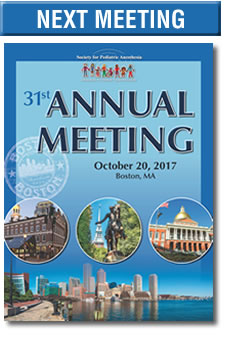spa-aap reviews
Friday, Session III - AAP Session
By Allison K. Ross, MD
Duke Children’s Hospital
Dr. Peter J. Davis, Recipient of the Robert M. Smith Award
Franklyn Cladis, MD (Pittsburgh Children’s) introduced Peter J. Davis, MD and shared why Peter is special to him and to others. Franklin acknowledged that what has been special with Peter are the relationships and connections that he made through his ability to make others feel seen, heard and valued. Peter started his training in pediatrics before Dr. George Gregory introduced him to anesthesia and critical care. He continued to be mentored in this area by Dr. Jack Downes in Philadelphia. Further mentorship occurred in Pittsburgh and his work with Dr. Etsuro Motoyama and Dr. D. Ryan Cook. Dr. Frank McGowen joined the team, and this group with Peter put Pittsburgh on the map in pediatric anesthesia.
Eventually, Peter was entrusted by Dr. Robert M. Smith with taking over the editorial job of Anesthesia for Infants and Children. This award takes Peter from training and working with giants to becoming one of those giants in our specialty.
At the conclusion of Franklyn’s speech, and on behalf of the AAP, Dr. Courtney Hardy presented the AAP Robert M. Smith Award to Peter J. Davis, who received a standing ovation.
Peter took the podium and chose to share a few things with the audience. He stated that the constant in life is change and adaptation is important. Peter spoke particularly about mentorship. One of Peter’s first mentors was his big brother; teaching him about ethical treatment - how to treat people. His 10th grade biology teacher taught Peter that smart people are a dime a dozen and it matters more what you do with your intelligence. The third person who impacted Peter was a botanist in college who encouraged Peter to take science classes and ask questions. Ryan Cook was described by Peter as a mentor who understood the academic process and took the time to mentor Peter along those pathways.
However, most important in Peter’s life has been his wife of 40 years and he stated that the award is really for her. Her support allowed this to happen and, according to Peter, “she completes me.” Along the way, his kids have been part of his mentorship and are quick to tell him when he is wrong. Now the mentorship continues with grandchildren who promote intellectual curiosity. Dr. Davis added that mentorship also comes from colleagues at work, at the journal Anesthesia and Analgesia, and the SPA Board.
He shared a couple of lessons that he has learned along the way. For one, he showed a humorous problem-solving guide and finished by stating that one must be articulate, be clear and communicate well.
His speech concluded with another well-deserved standing ovation.
Review of AAP Advocacy Lecture
Intensive Care Decisions for Fragile Neonates presented by Annie Janvier BSc, PhD, MD
Dr. Janvier started with the fact that there are more interventions and increased survival of neonates. However, with increased survival there are increased risks. This presents difficult decisions.
The Baby Doe Trisomy 21 issue generated much legislation, including the 1984 amendment whereby decisions weigh parental desire for treatment versus treatment efficacy. The difficulty is in deciding what “futility” means? Quantitative Futility applies numbers to a situation which may be physiologically futile such as a brain transplant where the chance of being successful is zero. Another example may include an intervention that works less than 5% of the time such as certain bone marrow transplants.
What is more common is Qualitative Futility. An example is CPR for a 90 year old patient with metastatic cancer. It becomes a value judgment. Neonates often fall in the grey zone where decisions range between beneficial and futile. In France, newborns weighing less than 600 grams and who are less than 24 weeks are not resuscitated because survival is zero. Looking at other areas of Europe and in many places in the US, survival can be as high as 70% in the same population. One must consider the long-term outmes even if survival may occur. 50% of certain premature neonates may be unimpaired but 15-20% have severe disabilities. Social factors often determine outcomes.
Interestingly, although health related quality of life (QOL) is measured to be worse in premature neonates than in normal newborns, subjective quality of life is similar to their peers with regard to friendships, living independently, etc.
Some neonatologists have used a “gestational age-based mantra” where they are making decisions on gestational age such that 22 weeks is futile, 23-24 are in the grey zone and 25 weeks is beneficial, but these decisions are based on a gestational age that may not truly be known. There are influences that affect survival more than gestational age such as birth weight, gender, steroid use, multiple pregnancy, social factors, etc. In addition, there are huge practice variations that affect outcomes. In the “rich” world, survival at 24 weeks is 0-84% with many factors affecting the results.
With regard to making decisions, parents are more optimistic than physicians, more tolerant of disabilities, they do not see QOL the same way as physicians do and the children themselves judge their QOL higher than their providers. Parents of in-utero babies with Trisomy 13 or 18 have big decisions to make prenatally. When parents were making the decision whether to take baby to term, they were told many different things by providers including that the diagnosis was incompatible with life, baby would be in constant pain, be a vegetable, marriage would be affected, etc. All of these children had significant disabilities but the parents stated that their goals were to meet their child alive, take them home, be a family and hope for the best. The parents also did state that their children had pain, caring for them was more difficult than expected and was a financial strain. Despite this, 98% stated their children had positive experiences and were happy with their decisions. Physicians should all be careful with words used when speaking to parents such as “incompatible with life”, “lethal”, “vegetable”, “waste of time, money, space”, “you can have another one”, “child will harm whatever”, “there is nothing we can do” and “we do not do anything for these children” as this makes parents feel that providers do not value their child.
Looking at the issues ethically, the guiding principle is what is in the patient’s best interest. In a survey of physicians, resuscitation was found to be in the patient’s best interest as the patients get older. So why use a mantra with a grey zone based on gestational age where older patients have no grey zone? Why are neonates less valued? Providers say that they are “not the same kind of person”, not attached to anyone, they have not lived a life, no experiences, etc. Dying in the delivery room seems easier than four months later in the NICU, for example. The value of time is different. Providers are also biased against premature infants thinking they will have bad outcomes. Theoretically and legally, neonates are actually equal to older patients, but in practice they are not treated equally.
In conclusion, Dr. Janvier acknowledged that what is described as being beneficial, futile or grey zone is relative and subjective. Physicians determine the grey zone, and if a neonate falls inside that grey zone, parents may help decide the degree of intervention, but the parental view and medical view may not be aligned. Therefore, we have the duty and responsibility to examine biases and values behind decisions and parents should be partners in the research.






